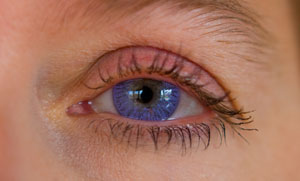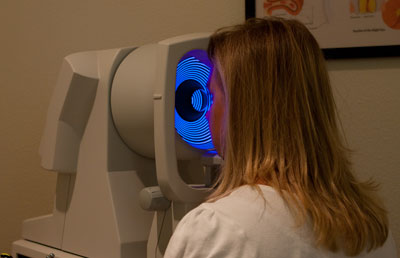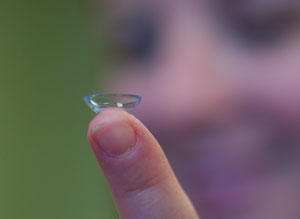Eye Exams for Contact Lenses
For many people, contact lenses provide greater convenience and more satisfying vision correction than eyeglasses. Here's what's involved in a typical contact lens exam and fitting:
Comprehensive Eye Exam

Before being fit with contact lenses, a comprehensive eye exam is performed. In this exam, Doctor Tanner determines your prescription for corrective lenses (just a glasses prescription at this point) and checks for any eye health problems or other issues that may interfere with successful contact lens wear.
If all looks good during your eye exam, the next step is a contact lens consultation and fitting.
Contact Lens Fitting
 The first step in a contact lens consultation and fitting is a consideration of your lifestyle and your preferences regarding contact lenses, such as whether you might want to change your eye color with color contact lenses or if you're interested in options such as daily disposables or overnight wear. Although most people choose soft contact lenses, the advantages and disadvantages of Rigid Gas Permeable (RGP) lenses will likely be discussed as well.
The first step in a contact lens consultation and fitting is a consideration of your lifestyle and your preferences regarding contact lenses, such as whether you might want to change your eye color with color contact lenses or if you're interested in options such as daily disposables or overnight wear. Although most people choose soft contact lenses, the advantages and disadvantages of Rigid Gas Permeable (RGP) lenses will likely be discussed as well.
If you are over age 40 and need bifocals, Doctor Tanner will discuss ways to deal with this need, including multifocal contact lenses and monovision (a prescribing technique where one contact lens corrects your distance vision and the other lens corrects your near vision).
Contact Lens Measurements
Just as one shoe size doesn't fit all feet, one contact lens size doesn't fit all eyes. If the curvature of a contact lens is too flat or too steep for your eye's shape, you may experience discomfort or even damage to your eye. Measurements that will be taken to determine the best contact lens size and design for your eyes include the following:

-
Corneal curvature: An instrument called a keratometer is used to measure the curvature of your eye's clear front surface (cornea). This measurement helps Doctor Tanner select the best curve and diameter for your contact lenses. In some cases, a detailed mapping of the surface of your cornea (called corneal topography) may be done. Doctor Tanner uses this to precisely measure and evaluate your corneal surface for a better contact lens fit.
If your eye's surface is found to be somewhat irregular because of astigmatism, you may require a special design of lens known as a "toric" contact lens. In the past, only RGP contact lenses could correct astigmatism. But there are now many brands of soft toric lenses, which are available in disposable, multifocal, extended-wear and colored versions.
- Pupil and iris size: The size of your pupil and iris (the colored part of your eye) can play an important role in determining the best contact lens design, especially if you are interested in GP contact lenses. These measurements may be taken with a lighted instrument called a biomicroscope (also called a slit lamp) or simply with a hand-held ruler or template card.
- Tear film evaluation: To be successful wearing contact lenses, you must have an adequate tear film to keep the lenses and your cornea sufficiently moist and hydrated. This test may be performed with a liquid dye placed on your eye so your tears can be seen with a slit lamp, or with a small paper strip placed under your lower lid to see how well your tears moisten the paper. If you have dry eyes, contact lenses may not be right for you. Also, the amount of tears you produce may determine which contact lens material will work best for you.
Trial Lenses
 In many cases, trial lenses will be used to verify the contact lens selection. Lenses will be placed on your eye and Doctor Tanner will use the slit lamp to evaluate the position and movement of the lenses as you blink and look in different directions. You will also be asked how the lenses feel.
In many cases, trial lenses will be used to verify the contact lens selection. Lenses will be placed on your eye and Doctor Tanner will use the slit lamp to evaluate the position and movement of the lenses as you blink and look in different directions. You will also be asked how the lenses feel.
You'll typically need to wear these trial lenses at least 15 minutes so that any initial excess tearing of the eye stops and your tear film stabilizes. If all looks good, you will be given instructions on how to care for your lenses and how long to wear them. You will also receive training on how to handle, apply and remove the lenses.
Follow-Up Visits
Your contact lens fitting may involve follow-up visits so Doctor Tanner can confirm the lenses are fitting your eyes properly and that your eyes are able to tolerate contact lens wear. A dye (like the one used to evaluate your tear film) may be used to see if the lenses are causing damage to your cornea or making your eyes become too dry.
Often, your doctor will be able to see warning signs before you are aware a problem with your contact lens wear is developing. If such warning signs are evident in your follow-up visit, Doctor Tanner may recommend trying a different lens or lens material, using a different lens care method, or adjusting your contact lens wearing time. In some cases, it may be necessary to discontinue contact lens wear altogether.
Your Contact Lens Prescription
After finding a contact lens that fits properly, is comfortable for you, and provides good vision, Doctor Tanner will then be able to write a contact lens prescription for you. This prescription will designate the contact lens power, the curvature of the lens (called the base curve), the lens diameter, and the lens name and manufacturer. In the case of RGP contact lenses, additional parameters may also be included.
Routine Contact Lens Exams
Regardless of how often or how long you wear your contact lenses, your eyes should be examined at least once a year to make sure your eyes are continuing to tolerate contact lens wear and show no signs of ill effects from the lenses.
Toric Contact Lenses for Astigmatism
If you have astigmatism - a common condition where the eye isn't perfectly round, but more football- or egg-shaped - then you'll need a special design of contact lenses called "toric" lenses for clear vision.
Toric contact lenses are available in both soft and RGP lens materials. Most contact lens wearers who need toric contact lenses choose soft toric lenses.
How do toric lenses work?
When you have astigmatism, different meridians of your eye need different amounts of correction for nearsightedness or farsightedness. Imagine the front of your eye is like the face of a clock: A line drawn from the 12 to the 6 is one meridian, a line from the 1 to the 7 is another, and so on.
Soft toric contact lenses have different powers in different meridians of the lens to correct the eye's astigmatism. They also have design elements to keep the lens from rotating on your eye, so the meridians of the lens stay aligned with the meridians of your eye.
Today, you can choose from many brands and styles of soft toric lenses. So if Brand A doesn't fit properly or rotates too much, Brand B may perform better. And if soft toric lenses don't adequately correct your astigmatism, gas permeable lenses will often do the trick.
Toric Contact Lens Cost
Properly fitting a toric contact lens takes more time and requires more expertise than fitting regular soft contact lenses. Several office visits are required, and sometimes several different lenses must be evaluated. Consequently, our professional fee for fitting toric lenses is higher than our fee for a regular contact lens fitting. The lenses themselves also cost more than regular soft lenses. Call our office for details.
RGP Lenses for Astigmatism
If you have a mild to moderate amount of astigmatism, you may want to consider gas permeable contact lenses. RGP lenses usually provide sharper vision than soft toric lenses. Because RGP lenses are rigid and maintain their shape on the eye, a toric RGP design usually isn't needed. The astigmatism due to unequal curves on the front surface of your eye is corrected by a layer of tears that forms between your eye and the spherical back surface of the RGP lens.
If regular RGP lenses fail to adequately correct the astigmatism, customized toric RGP lens designs are also available.
Many Options in Soft Toric Lenses
Today, many brands of soft toric lenses are available and you have a choice of lenses approved for daily wear (lenses you remove before sleep) and extended wear (lenses approved for overnight wear). There are also soft toric lenses to enhance or change your eye color and multifocal toric lenses if you have presbyopia.
Bifocal and Multifocal Contact Lenses
Bifocal and multifocal contact lenses are designed to give you good vision when you reach your 40s. Beginning at this age, you may need to hold reading material - like a menu or newspaper - farther from your eyes to see it clearly. This condition is called "presbyopia."
Bifocal and multifocal contact lenses are available in both soft and rigid gas permeable (GP) materials.
Bifocals, Multifocals - What's the difference?
Bifocal contacts lenses (like bifocal eyeglass lenses) have two powers - one for seeing clearly far away and one for seeing clearly up close. Multifocal contact lenses, like progressive eyeglass lenses, have a range of powers for seeing clearly far away, up close and everywhere in between. ("Multifocal" is also a catch-all term for all lenses with more than one power, including bifocals.)
Types of Multifocal Contact Lenses
Based on design, there are basically two types of multifocal contact lenses:
-
Simultaneous vision lenses: With these lenses, both distance and near zones of the lens are in front of your pupil at the same time. Although this might sound unworkable, after a short period of time your visual system learns to use the power you need and ignore the other lens power(s), depending on what you are looking at. Simultaneous vision lenses are the most popular type of multifocal contact lens. They are nearly always soft lenses, and are available in two designs:
- Concentric ring designs - These are bifocal lenses with either the distance or near power in the center of the lens, with alternating rings of distance and near powers surrounding it.
- Aspheric designs - These are progressive-style multifocal lenses, with many powers blended across the lens surface. Some aspheric lenses have the distance power in the center of the lens; others have the near power in the center.

- Alternating vision (or translating) lenses. These are GP multifocal lenses that are designed like bifocal eyeglass lenses. The top part of the lens has the distance power, and the bottom part of the lens contains the near power. When you look straight ahead, your eye is looking through the distance part of the lens. When you look down, your lower lid holds the lens in place while your pupil moves (translates) into the near zone of the lens for reading.
How to Know if Multifocal Contact Lenses Are Right for You
Most people who try multifocal contact lenses are happy with them. But some compromises may be necessary when you wear these lenses. For example, your distance vision with multifocal contact lenses may not seem clear enough, or you may have troubles with glare at night or not being able to see small print.
In some cases, a better solution for presbyopia may be a monovision or modified monovision fitting of regular ("single vision") contact lenses.
With monovision, you wear a single-vision contact lens on one eye for your distance vision and a single-vision contact lens on the other eye that has a prescription for your near vision. In modified monovision, you wear a single-vision "distance lens" on one eye and a multifocal contact lens on the other eye to help you see better up close.
Call for more information
Call our office today to learn more about contact lens options for presbyopia, astigmatism, myopia and hyperopia or to schedule a contact lens consultation to find out which lenses are the best solution for you.